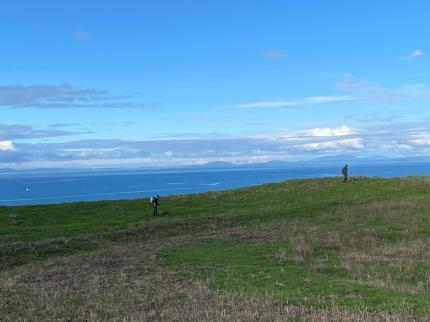Managing Wildlife Populations
Goose Surveys: Biologist Cent and Novack conducted their bi-monthly surveys of dusky Canada geese across Grays Harbor and Pacific counties.
Olympic Peninsula Technical Elk Meeting: District 17 Biologists Novack and Cent attended a coordination meeting with tribal and non-tribal representatives regarding elk management and monitoring on the Olympic Peninsula.
Marbled Murrelets: Biologist Tirhi assisted with the murrelet captures on four separate occasions and was involved in the capture of 3 of the 5 total marbled murrelets captured for the research project (and one ancient murrelet). Marbled murrelets are a state and federally listed species. This study was designed to capture marbled murrelets for prey diet research and is funded by the U.S. Navy.


Oregon Spotted Frog: The frog season is off to a slow but steady start across south Puget Sound. Biologist Tirhi has spent several days conducting early season surveys including at the Salmon Creek breeding site where the first ten egg masses were recorded. Tirhi has also spent time mapping out wetlands across four focal areas of Thurston County and researching land ownership and access permission in order to conduct the 2024 surveys.
Conserving Natural Landscapes
Protection Island Restoration: Wildlife Area Manager Laushman and Technicians Morgan and Norris visited the Zella Schultz Unit on Protection Island for ongoing restoration work. They seeded native species and applied herbicide to germinating invasive species on the island.

South Puget Sound Weed Control: Technician Morgan continued mowing of Scotch broom on the northern hillsides at the South Puget Sound Unit in Lakewood and cleared thick areas of Scotch broom near the Lakewood Hatchery. Wildlife Area Manager Laushman treated patches of spurge laurel and poison hemlock.


Region 6 Office Wetlands Restoration: Biologists Novack and Cent, along with wildlife area technicians and customer service staff members, planted willow stakes in the wetland area behind the regional office in Montesano. The wetlands are overrun with exotic reed-canary grass and yellow-eyed iris which prevents natural succession. Protective wiring was installed around the planted willows to prevent deer and beaver damage during initial establishment.

Prairie Species and Oregon Spotted Frog land protection: Biologist Tirhi spent considerable time working with Land Protection Lead Frediani on creating a GIS mapping tool to prioritize land acquisition and conservation priorities for Thurston County. Tirhi and Frediani met individually with U.S. Fish and Wildlife Services, Thurston County, and Washington Water Trust to showcase the tool and discuss partnerships for implementation. This partnership will continue and will use various funding sources to acquire or otherwise protect lands for these priority species.
Providing Education and Outreach
Puyallup Sportsman Show: Biologist Tirhi covered one shift at the annual sportsmen show held at the Puyallup fairgrounds.
Conducting Business Operations and Policy
Capital Project Proposal: Biologist Novack, working in conjunction with Wildlife Area Manager Bechtold and Kronland, submitted a proposal for removing derelict structures on the Chehalis and Davis Creek units concurrent with constructing an ADA accessible observation platform at Davis Creek.
Tracked All-Terrain Vehicle (ATV): Biologists Butler and Tirhi spent several hours cleaning out a donated space at one of the Washington Department of Fish and Wildlife fish hatcheries for the storage of the district’s tracked ATV used for winter surveys and monitoring. The desire was to move the machine from the open into an enclosed area to prevent rust. District 11 is grateful to the Hatchery Program for allowing the use of the space.
